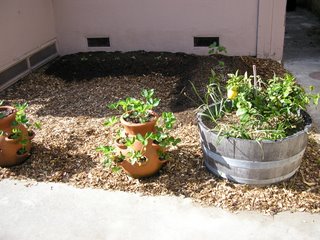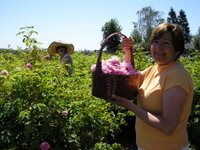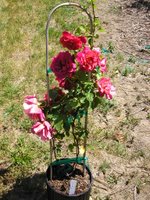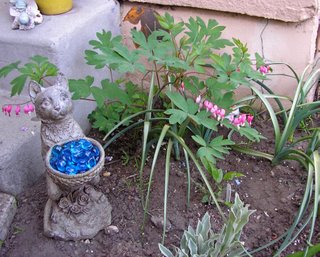
During my first couple years in this garden, when I had no money to spend on plants (actually, I still have no money to spend on plants, but that no longer seems to prevent me from doing it), I thought the idea of reseeding annuals was like manna from the heavens. For the price of a few packets of seeds, I thought that I would be able to fill my yard with a variety of blooms not just for one season but year after year. So when I planted Cosmos the first year and got a lovely stand of 4-foot tall white, pink and magenta flowers, I was happy. When they came back the next year and spread out a few feet to make an even showier display, I was thrilled. However, when they came back the third year and turned my largest bed into a 5-foot tall meadow, I began to know fear. Last year, I fought back, thinning and yanking to little avail. This year, I was ruthless--I smothered them with newspaper and mulch.
I now think of reseeding annuals less like manna from the heavens and more like Trojan horses. You welcome them into your yard like a lovely, unexpected gift, but when you're not looking they invade and take over your garden like a horticultural army in the night. With smaller species--marigolds or forget-me-nots, for example--I'm happy to let them have their run of the place. Should I want to get rid of them, they're easy enough to transplant or just yank and toss. But with bigger or more stubborn plants, reseeding is no gift--it's a strategy for world domination.

Case in point: Four O'Clocks, or as I now think of them, Those Damn Four O'Clocks (
Mirabilis jalapa damnus). The
Sunset Western Garden Book says about this innocuous-looking flower "reseeds readily." Understatement of the year! Not only do these plants drop hundreds of little black seeds that sprout ever so easily, but they also develop tuberous roots that you may need dynamite to get rid of. Some of the ones I've pulled out have been bigger than my hand. Some of them break as you're pulling them out and the broken bits will still sprout. Some have been so determined to stay put that I've bent two trowels trying to pry them loose. After several hours of work a few weeks ago, I thought I had cleared an entire bed of all the tubers. But no. They are back with a vengeance and the battle continues.

And now it appears I may have invited another Trojan horse through the garden gate. What I mistook for large, round buds on the delphiniums are actually seed pods, and already I'm pulling out new shoots from among the stalks that are now more than 5 feet tall. I don't mind the delphiniums that are presently there. Although the flowers are not what I expected, they are filling the spot well enough for the time being and they look good against the tall fence at the back of the yard. I did not intend, however, to have to wage war with them year after year. For one thing, once mature, their woody stems aren't easy to pull out. And for another, they're bigger than me.
I guess I just wish that those plants that are out-of-control breeders would come with a warning label--a real warning label, not just a mild "reseeds readily" statement. Or maybe it's time to create a whole new genus for these types of plants. Does anyone know the latin term for "invasive barbarian"?
 This is one of the many recent volunteers in my garden and I would love to know its name. It stands about 18 inches high right now, its leaves are sessile and opposite with surfaces about as hairy as an African Violet (less hairy than a Wooly Lamb's Ears). It has just come into bloom in the last few days (the magenta bloom on top--the flower below that is a freesia).
This is one of the many recent volunteers in my garden and I would love to know its name. It stands about 18 inches high right now, its leaves are sessile and opposite with surfaces about as hairy as an African Violet (less hairy than a Wooly Lamb's Ears). It has just come into bloom in the last few days (the magenta bloom on top--the flower below that is a freesia).



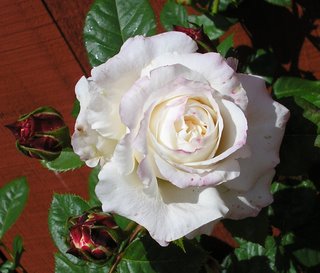
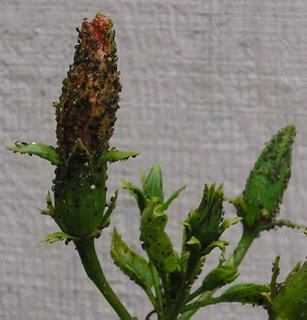
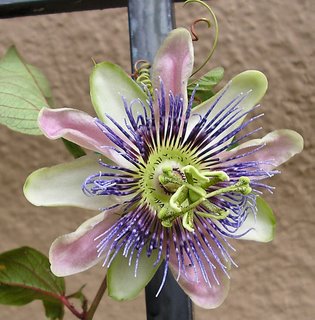 Big reward today! The passion flower vine that I've been fretting about surprised me with its first bloom. There's just something about these alien-looking flowers that I love and I hope that someday the struggling little vine I've been pampering will flourish like the one I remember in my Aunt Helen's yard. That one spread across her entire back fence and bloomed like mad.
Big reward today! The passion flower vine that I've been fretting about surprised me with its first bloom. There's just something about these alien-looking flowers that I love and I hope that someday the struggling little vine I've been pampering will flourish like the one I remember in my Aunt Helen's yard. That one spread across her entire back fence and bloomed like mad.
